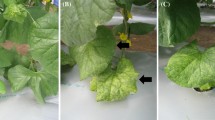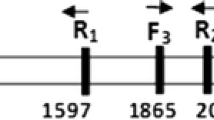Abstract.
Genomic and cDNA fragments with homology to known disease resistance genes (RGH fragments) were cloned from Cucumis melo using degenerate-primer PCR. Fifteen homologues of the NBS-LRR gene family have been isolated. The NBS-LRR homologues show high divergence and, based on the partial NBS-fragment sequences, appear to include members of the two major subfamilies that have been described in dicot plants, one that possesses a TIR-protein element and one that lacks such a domain. Genomic organization of these sequences was explored by DNA gel-blot analysis, and conservation among other Cucurbitaceae was assessed. Two mapping populations that segregate for several disease and pest resistance loci were used to map the RGH probes onto the melon genetic map. Several NBS-LRR related sequences mapped to the vicinity of genetic loci that control resistance to papaya ringspot virus, Fusarium oxysporum race 1, F. oxysporum race 2 and to the insect pest Aphis gossypii. The utility of such markers for breeding resistant melon cultivars and for cloning the respective R-genes is discussed.
Similar content being viewed by others
Author information
Authors and Affiliations
Additional information
Electronic Publication
Rights and permissions
About this article
Cite this article
Brotman, .Y., Silberstein, .L., Kovalski, .I. et al. Resistance gene homologues in melon are linked to genetic loci conferring disease and pest resistance. Theor Appl Genet 104, 1055–1063 (2002). https://doi.org/10.1007/s00122-001-0808-x
Received:
Accepted:
Issue Date:
DOI: https://doi.org/10.1007/s00122-001-0808-x




